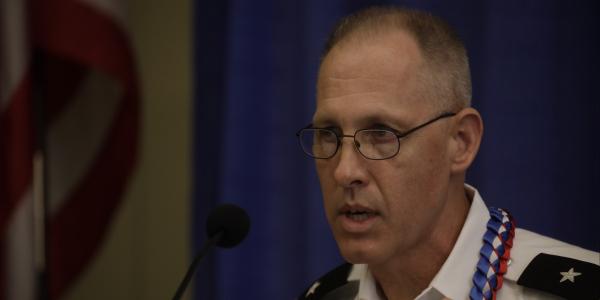Cyber Is at the Heart of Indo-Pacific Command Strategy
Across the vast Indo-Pacific region, all roads lead to cyber, according to a panel of U.S. and foreign military and civilian experts. Speaking on the final day of AFCEA’s TechNet Asia-Pacific 2018, held November 14-16 in Honolulu, the panel discussed the need for interoperability amid growing cybersecurity concerns.
We must deliver full spectrum cyber operations anywhere in region in conjunction with land, sea, air and space.—Brig. Gen. Paul. Fredenburgh III, USA, J-6, @INDOPACOM #AFCEATechnet
— Bob Ackerman (@rkackerman) November 15, 2018
The focus on cyber parallels the thrust of the new National Security Strategy, explained panel moderator Brig. Gen. Paul Fredenburgh III, USA, J-6, Indo-Pacific Command (INDOPACOM). “This is a change in our national strategy, and we need to adjust to that specifically in a cyber environment,” he declared. “Today, we are expected to have to compete in every single domain, and that includes cyberspace. Our adversaries are leveraging cyberspace to conduct operations below the threshold of conflict.”
Today, we are expected to have to compete in every single domain, and that includes cyberspace.—Brig. Gen., Paul. Fredenburgh III, USA, J-6, @INDOPACOM #AFCEATechnet
— Bob Ackerman (@rkackerman) November 15, 2018
Gen. Fredenburgh emphasized that, “We must deliver full spectrum cyber operations anywhere in the region in conjunction with land, sea, air and space. We must look at posturing and designing networks for operational effects.” The general added, “If we are going to be told that we cannot go it alone, then we must design a network that allows us to be interoperable with our allies and partners.”
One of those partners is Canada, and Brig. Gen. J.R.P. Laroch, RCAF, is the deputy J-3 for INDOPACOM. “Moving forward, space and cyber will be an essential part of any multinational activity,” he stated.
Col. Joseph Matos, USMC, Marine Corps Forces Pacific, warned that technology alone is not the solution to coalition interoperability. “For our coalition partners, throwing them more gear is not the answer,” he offered. “It’s the process of using that gear smartly.” He continued that planners should be thoughtful in how they equip partners for interoperability.
The increased role for cyber brings with it a greater need for security, and some panelists described how their organizations are addressing it. Brig. Gen. Moses Kaoiwi, USA, Hawaii National Guard, Joint Force Headquarters, noted that Hawaii’s critical infrastructure is vital for mission assurance. The Guard has just formed a cyber mission assurance team, or CMAT, that will be on a par with its already established chemical, biological and nuclear (CBN) emergency response team. Like that team, the CMAT will develop partnerships within Hawaii among government agencies and industry.
Our critical infrastructure in Hawaii is critical for mission assurance.—Brig. Gen. Moses Kaoiwi, USA, HING, Joint Force HQ #AFCEATechnet
— Bob Ackerman (@rkackerman) November 15, 2018
“Rapid response is key to addressing whatever threat is out there, physical or cyber,” Gen. Kaoiwi said. “To address a threat, terrorist or natural, I’ve got to have the information. I need a common operating picture that is easily protected from an insider threat so I can allocate resources.”
Col. Glen M. Genove, USAF, A3/6, U.S. Pacific Air Forces, stated that, “We are restructuring our base forces to become more of the beat cops for the networks at the base.” He added, “Virtualization of our networks has enabled a lot of our progress. Now, we are enabling the capability to have one machine access a number of networks. We will have multinetworks visible on a single pane of glass at one time.
From an IT perspective, it’s all about connectivity. We have to enable that process and platform to flourish to enable learning so users can query about anything and get a response.—Col. Glen M. Genove, USAF, A3/6, U.S. @PACAF #AFCEATechnet
— Bob Ackerman (@rkackerman) November 15, 2018
“From an IT perspective, it’s all about connectivity,” the colonel continued. “We have to enable that process and platform to flourish to enable learning so users can query about anything and get a response.”
Mark your calendars for AFCEA next Hawaii TechNet conference and exposition, to be held November 19-21, 2019, in Honolulu.





Comments